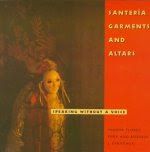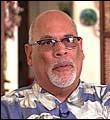A psychiatrist’s couch is no place to debate the existence of God. Yet spiritual health is an inseparable part of mental or psychological health. Something no psychiatrist should regard with clinical indifference. But what does spiritual or religious health involve? This can’t just include normalized versions of monistic theism – but the entire set of human dispositions that may be thought of in spiritual terms.
The post Unwholly bound: Mother Teresa’s battles with depression appeared first on OUPblog.
3:00 am on a Saturday morning—Granny in her nightclothes, repeats a welcoming ritual for our family. We’ve just arrived from Indiana to spend the weekend or a holiday. She and Grandpa knew we were coming.
Granny had prepared for our arrival with her usual comfort feast. She knew we’d be famished by the time we stepped through her door. To stave off those awkward growling sounds that would surely keep everyone awake for the rest of the night, she loaded the groaning board with a southern breakfast. It doesn’t seem to matter to her or Grandpa that by the time we finish eating, and unwind enough to go to sleep, they will be preparing for their farm day.
My brother and I sit at that big farm kitchen table, eyeing the platters, bowls, plates, and jars that she arranges down the center of the space. Medium platter supports three different types of fried eggs: hard, soft, and scrambled.
Her infamous small square biscuit pan sits on a handmade potholder near the homemade jams, jellies, and syrup for the golden brown pancakes hoarding their own personal bowl. Sausage patties, country ham, and leftovers from last night’s fried chicken hold court on a large platter on Dad’s end of the table.
Fresh coffee perfumes the room, aided by fresh milk, and rounds out the “impromptu” meal, along with real farm cream to use on cold cereal.
Yep, we’re down home. An hour later, family talk has dwindled enough to expose sleepy eyes and yawns. Bedtime has come at last.
If we’d come during the winter, those upstairs beds would act as ice cube trays waiting to be filled. The upstairs of that house had no heat of its own. Heck, the down stairs only had Warm-Morning stoves that could take wood or coal. Finances determined which fuel was used.
Mom and I would take one bed and Dad, with brother, would get the other one. There were so many of Granny’s homemade quilts on the beds that Mom would have to hold up the covers so that I could position myself. Once I was comfortable, she’d lower the bedclothes.
I had to be very certain of comfort in that position because once those quilts lowered; I wasn’t strong enough to shift my position under them. They were heavy and cold upon first entry to the bed. As a rule, I would try to put my back to my mom’s. Her body heat would keep me from becoming an ice cube until my own body heat took care of warming my space. Sleep was the only refuge until real heat came along.
In the summer, only those floor to ceiling windows gave relief from the sweltering upstairs heat. No quilts were required for that season. The fear then was melting into the feather beds.
Dawn and downstairs activity led to anxious dreams and disrupted, food-induced sleep. Grandpa had milking to do. Granny had to get lunch on the stove so that she could take a bit of socializing time once all the kin arrived for that meal. These things didn’t take care of themselves.
Throughout our visit, for however long it lasted, that lady of the South, cared for the feeding and comfort of her quests. She prided herself in always having enough for anyone who happened to drop by on any given day. No one left he home without taking a meal with them.
A weekend lunch would supply victuals for a minimum of sixteen to twenty people, depending on family sched
Random Acts of Publicity DISCOUNT:

$10 OFF The Book Trailer Manual.
Use discount code: RAP2011
http://booktrailermanual.com/manual
 I’m sending out my novel today. Long ago, when submissions were paper, writers and authors often went through rituals to send out a manuscript for their novel or picture book.
I’m sending out my novel today. Long ago, when submissions were paper, writers and authors often went through rituals to send out a manuscript for their novel or picture book.
- A lucky cat had to sit on the manuscript.
- It had to mailed with certain types of stamps.
- You kissed the envelope for luck.
IN these days of digital submissions, what is your favorite ritual before hitting the SEND button? Please leave a comment and share your rituals. I need to know what works!


Santeria Garments and Altars is a literate, accessible, beautifully photographed book by a man who is a member/initiate in a house of Oshun. Its subtitle is, ‘Speaking Without A Voice.’ How appropriate! The emphasis is the striking photographs of the variety of altars to the different deities, members of a variety of houses preparing for, or engaged in aspects of worship.
By way of background information -- A ‘house’ is a group of devotees of a particular god or goddess under the leadership of a ‘babalawo’, or priest/priestess. Oshun is another one of the Seven African Powers who represents the archetypical female principle and the power of eros. Interestingly enough, abstinence or asexuality, and a virginal principle of female sexuality has no icon, nor any particular social importance.
Another interesting feature is that the author is a male practitioner, much in the tradition that the gods choose individuals to serve them regardless of gender. My own Catholic upbringing was full of gender separation, nuns as brides of Christ, servants of the male hierarchy, etc. While there are some tasks separated by sex, it does not appear to be as rigid, as attenuated as in a Christian/Catholic context.
One off the major tenets of this religious practice is the construction of altars, which every believer is required to do. There’s a synthesis between aesthetic and spiritual significance. It is considered one’s duty to create, as service to the deity to whom one has pledged oneself. A further illustration of the nexus between creativity and belief is the Santeria/Yoruba belief in ‘ache’, the universal life force present in all things. Each devotee is assumed to have within them the power to create a beautiful altar, one infused with ‘ache.’
In my performance pieces, there are ‘anchor ‘ points--static elements that have life infused into them. (In REM/Memory, there is a central, supine figure, hidden in a mass of blankets, who comes alive as the piece starts, and the nightmare begins. In Resurgam, a chaos of white fabric is stripped away to reveal a captive figure who finds release as the piece begins.) I see a similarity between a finished altar containing ‘ache,’ and a performance’s ‘anchor’pieces being the place where it all comes alive, more specifically, where it reflects at least the possibility of sacred ritual.
There are several points of connection for me here. When the author created an altar to Oshun, it was clear that it could also be seen as a ‘site-specific installation.’ Size of the space, mood of the space, prominent observation points are all taken into consideration. These are the same consideration I make with each piece, the same considerations any installation artist might make.
In the design of an altar dedicated to Oshun, ‘found’ elements are brought into the piece that symbolize her attributes. Since Oshun represents eros, obvious choices illustrate sensuality. Honey, honeycombs, silks and laces are standard items in such an altar. I constantly bring found items from daily life into my performances, hoping to create common imagery for myself and the audience as it unfolds as a shared experience. In Resurgam, during the 'communion’ section, I offer a papaya sliced in half to the audience, sharing its womb shape with them as the symbol of The Living Body--juicy, ripe, the source of all things, ever replenishing.
Lastly, I want to comment on the Santeria idea of ‘coolness.’ Essentially, it is the principle of balance, harmony, a reflection of the connectedness of all things. An altar, no matter how ornate, is not considered ‘cool’ if it does not have these attributes.
Even though my approach is spare, I try to layer things enough to suggest complicated ideas and experiences. It's work with a a consistent point of view, root motifs that I communicate to the audience, an arc of interconnectedness between myself, how I tell the story, the audience, and a unifying force that exists in the moment of performance, a force that I call Spirit.
xxxxxxxxxxxxxxxxxxxxxxxxxxxxxxxxxxAbout the author:

Dr. Flores-
Peña was born in San Juan,
Puerto Rico. Studies: University of
Puerto Rico, B.A, Catholic University of
Puerto Rico, MA. Ed. UCLA M.A and
Ph.D. Publications and lectures on Afro-Caribbean Ritual Art and Afro-Cuban religious cultures and Latino Folklore. Lecturer at WAC, Center for Afro-American Studies, and Adjunct Professor at Otis College of Art and Design.
ISBN-10: 087805703X
ISBN-13: 978-0878057030
Lisa Alvarado
In the 1985 August/September issue of the Utne Reader, in an article entitled Revamping the World, Deena Metzger puts forth an challenging concept to consider in a post-feminist context. She challenges both men and women to consider the body and eros as a vehicle of communion, restoration, and redemption instead of merely recreation, or anesthetization.
Metzger decries the limits of the last wave of Western feminism, stating it negates women's inherent power in its disavowal of female body itself, its inherent receptivity. She is disturbed by what she views as the attempts of women to refashion themselves using traditional male, Western models of power and achievement. She believes that women, trying to access a kind of power based in patriarchy, are losing their inherent strength. It is a strength of intuition, and connectivity, a strength that Metzger herself struggled to embrace.
This is not a new belief for us. Our roots, our spirituality before the conquest is rife with images of cosmic coupling. It is a spirituality based on a cyclic wisdom, linked to eternal regeneration contained in bodies of our dioses y diosas, and within ourselves.
Metzger's idea of female power is one that is frankly, clearly sexual. It is not ashamed of the body and its uses, but rather uses that body as the primary vehicle for reconnection and redemption. A very different notion for the traditional ideas of female sexuality I encountered through a Catholic upbringing. Metzger finds it ironic, and somewhat dangerous that women are trying to fashion themselves into men, rather than men and women reconnecting with a holistic view of the body, the spirit and the planet.
According to Metzger, what is necessary is a vision that re-sanctifies the body of woman, both literally and figuratively. I was deeply moved and challenged by Metzger's assertion that a return to the body and its rhythms that will have a global impact on consciousness and society; that once reconnected, we must be charged with nurturing and protecting our communities and the larger world beyond.
In describing a meditation in which she encountered an image that forever altered her life, Metzger writes that she was irrevocably altered by an image that appeared in a guided meditation. In it, she confronts her own dread in encountering a large, luminous, all encompassing image of a goddess figure. This following quote reveals what this encounter made her realize. Metzger states it is precisely the role of women to embrace their sexuality, not only for themselves, but as a tool of revolution, healing and social change.
It means that we must become vamps again, sexual-spiritual beings, that we must act out of eros. This means we must alter ourselves in the most fundamental ways. We cannot become the means for the resanctification of society unless we are willing to become the priestesses once more who serve the gods not in theory and empty practice, but from our very nature. It means that we must identify with eros no matter what the seeming consequences to ourselves. Even if it seems foolish, inexpedient, even if it makes us vulnerable, it means that we cannot be distracted from this task (of re-feminizing the planet) by pleasure, power, lust or anger. It requires a sincere rededication.
As contradictory and difficult a commitment it may be, she calls upon women, (I would also argue that men must consider this as well) to become Holy Prostitutes, reconsecrating their bodies to vamp and revamp the world.
What are the implications of such a stance? What call to action is Metzger making? What does it mean to revamp a society?
First, I think it means we ask ourselves with whom are we having sex, and why? Is it pleasure alone, is it distraction, is it sedation, is it a way to control? For our young people especially, is it sport sex, trophy sex, where the physical, emotional and spiritual stakes are high? But I think we would be doing Metzger and ourselves a deep, deep, disservice if this article were read as a call to harken back to the sixties, seeking the answer in a massive love-in of sorts, some narcotic tidal coupling that will magically cures all ills.
What does Metzger mean by transforming one's self into the Holy Prostitute? What is the connection between her assertion and our daily lives? Again, Metzger throws down the proverbial gauntlet.
It is to commit to eros, bonding, connection, when the (Western) world values thanatos, separation, detachment...So it is not sex we are after at all, but something far deeper....The task is to accept the body as spiritual, and sexuality and erotic love as spiritual disciplines, to believe that eros is pragmatic. To honor the feminine even where it is dishonored or disadvantaged.
As an artist and writer, I was moved on the deepest level by her challenge to 'Re-vamp' the world. 'Re-vamping' calls us to use the power of the body, free from the shame of patriarchal culture to change the world. It is the supreme play on words, with Metzger throwing down the gauntlet to readers, challenging us to rededicate ourselves to eros. It requires fully reclaiming sexuality as vehicle of connection, not merely in the literal sense, however. It means merging body and spirit and in some way developing a personal practice that we must we offer to the community-at large.
This idea of revamping the world has inspired me to explore movement-based ritual pieces where I examine, exploit, recover, and reveal my own physicality and sexuality. To begin to reconnect with eros in these pieces has meant taking my personal story, distilling it and recasting it with poetry, spoken word and dance. Metzger mentions thanatos, separation, and detachment as the benchmark of Western culture. These ideas are precisely what I want to contradict. It has forced me to more deeply connect with my body, its sensuality, to sharpen and hone that sense of physicality in order to use it as a conduit for narrative. Each of the pieces has some element where I ‘vamp’ the audience, communicate with them in a visceral, voluptuous way.
It has also influenced me to write work that is explicit, where sex is a metaphor and a commentary, and to risk being vulnerable in other work, in the rest of my writing, and my personal life.
Metzger closes her article with a series of questions that I'm enclosing, hoping it will fire your imagination as it did mine.
Whom do I close myself against?
When do I not have the time for love or eros?
When do I find eros inconvenient, burdensome, or inexpedient?
When do I find eros dangerous to me?
When do I indulge in the erotic charge of guilt?
Where do I respond to, accept, provoke the idea of sin?
When do I use sexuality to distract rather than commune?
When do I reject eros becuase I am rejected?
When do I abuse the body?
How do I reinforce the mind/spirit?
When and how do I denigrate the feminine?
When do I refuse the gods?
When do I pretend to believe in them?
When do I accept the gods only when they serve me?
How often do I acquiesce to the "real world?"
It's been over ten years since I first read this article. I won't pretend to agree with all of it, or have fully integrated the things that resonated with me. In that respect, I'm still a work-in-progress. What I do know is this: I'm interested in waking up, in staying awake, in connecting with others personally and within the body politic. I want to talk about storytelling and its healing potential, and the communal experience of the body. Metzger's article shook me up, challenged me, made me think, and I hope it's the beginning of a conversation between us.
A post script from Deena Metzger's site: "Re-vamping the world: On the return of the Holy Prostitute." Utne Reader, Minneapolis, Minnesota, August/September 1985. Reprinted in: To Be A Woman, The Birth of the Conscious Feminine, ed. Connie Zweig, Jeremy P. Tarcher, Inc. Los Angeles; Critique, ed. Bob Banner, P.0. Box 91980, West Vancouver,B.C., V7C 4S4. #33, Spring 1990; Enlightened Sexuality, Essays on Body-Positive Spirituality, ed. George Feuerstein, The Crossing Press, 1989; Iron Mountain, Florence, Colorado, Spring 1986, Vol. 1, No. 4; Reprinted (in expanded form) Anima, Chambersburg, Pa., Vol. 12, No. 2, Spring equinox 1986. Green Egg, 1996












Que interesante, siempre es bueno conocer otras culturas y enrriquecer el espiritu.
Besosssssssssssssss.............
Mai assaggiato questo caffè...mi piacerebbe. Come si prepara?
Ciao Pepi e ciao Sandra
Questa del caffè eritreo
...è una procedura particolare, come un rito magico.
Il caffè (ovviamente chicchi verdi di caffè) è stato prima tostato sul fuoco, in un pentolino. Poi messo in un'apposita caffettiera di coccio, tipicamente eritrea. E poi l'abbiamo bevuto, e ti assicuro che non mi era mai capitato di bere un caffè così buono ...e in così piacevole compagnia :)
Finita la terza tazzina ovviamente viene letto il fondo del caffè ;P
Preparare questo caffè è come dipingere...richiede cura, precisione e anche un po' di magia!! Ottimo abbinamento!
:) Quanto hai ragione MaestraLaura!
...è bello guardarsi intorno e accorgersi di quanto siano preziose e belle certe persone, di quanto ognuno abbia da raccontare di sè, della propria strada e del proprio destino, di come ognuno riesca a farlo con i mezzi che gli sono propri, facendoli diventare universali e comprensibili anche a chi non appartiene alla stessa cultura! Di come la cura usata per fare un caffè possa avere il potere di trasportarci in un'altra dimensione, di farci sentire gli odori di un'altra terra, di un'altra storia, così lontana ma così vicina a noi...
in questi momenti mi sento davvero molto fortunata e vorrei che tutti potessero sentirlo :)
oo non potevo resistere al profumo...è vero che è bello.
E son contenta che hai avuto l occassione di fare questa esperienza bellissima.
è sempre bello condividere le piccole grande cose con persone che vuoi bene :-) ciao ps anche ciccio lo pensa